You are currently browsing the category archive for the ‘Pamela Colman Smith’ category.
I just discovered this previously unknown photo of PCS by her friend, the well-known photographer, Alice Boughton. The source is The Literary Digest, July 4, 1908. Enjoy.


Emily Dickinson as HP
I recently stumbled across a web article on Pixie Smith that makes me want to stop the presses of Pamela Colman Smith: The Untold Story and add it as an appendix. Then I was delighted to discover that the author, Thea Wirsching, is creating a new deck, The American Renaissance Tarot, with artist Celeste Pille, based on esoterically-inclined religious influences in early 19th c. American literature (bios). PCS fits into this obliquely as an American artist (living in England) whose Colman-side grandparents were publishers and prominent Swedenborgians and who created an esoteric tarot that became America’s most iconic deck. In addition to fleshing out some of Pixie’s notable ancestors and making the point of just how thoroughly she emerged out of a lineage of early American ‘royalty,’ Wirsching examines the difficult issue of Smith’s racial appropriation of Jamaican folklore and patois.
In addition to Emily Dickinson, the Major Arcana of this deck includes figures such as Thoreau, Emerson, Walt Whitman, the Fox sisters and Margaret Fuller. An entire suit is dedicated to Poe and another to Hawthorne (The Scarlet Letter). Wirsching’s blog includes examples of the kind of depth of analysis you’ll find for each card. This deck belongs among other great decks that not only serve as divinatory devices but also contain teachings of cultures and cultural artifacts, that bring us insight into the human condition, such as the Matthews’ Arthurian Tarot and Celtic Wisdom Tarot or Diane Wilkes’ Tarot of Jane Austen and Ed Buryn’s The William Blake Tarot of the Creative Imagination. These decks introduce us to and, indeed, educate us in areas to which we might not have otherwise paid that much attention.
Wirsching and Pille are planning on completing the deck and book this year and are currently looking for a publisher or alternative publishing option. At this point, you can help subsidize the artist’s expenses by buying a print.
In the blog article on Pamela Colman Smith, Wirsching, an astrologer and a professor of American literature, praises the recent biography of Smith (which I co-wrote) recounting her SQUEEE reaction. She goes on to explore “the complicated history of colonial privilege and racial appropriation,” claiming these speak to “the fundamental Americanness of Pamela Colman Smith.” This is a discussion that deals with the very issues that are confronting us (forever anew) in the world today, especially as Smith is being claimed as a woman of color on so many websites and in social media. A part of me wishes it were so, however the facts of her life make it near impossible.

Smith’s grandfather, mayor of Brooklyn and a NY state senator.
With humor and extensive knowledge of early American history, Wirsching explains how Smith’s ancestors on both sides were among the earliest and most prominent in America: “the first Smith on that side of her family arrived in the colonies in the 1630s, and another direct relative in the Smith line was purportedly felled by witchcraft – that crazy fad that spread through New England in the late 17th century,” and “Pixie Smith’s Colman ancestors . . . were actively engaged in establishing the character of American art and letters in the nation’s early period.” I learned so much about her ancestors than I hadn’t known before, in what rivals a captivating episode of PBS’s “Finding Your Roots.”
Wirsching then gets to her real concern. While “culture has always been and always will be syncretic, formed by the “mixing together” of discrete traditions,” she also claims, “we can view Smith’s West Indian performances as a type of minstrelsy . . . if someone wanted to dismiss her as a culturally appropriating black impersonator, they could.” Ah, there’s the rub! Unable to give a settled opinion on this, Wirsching manages to present us with one of the most thoughtful explorations of this conundrum that is so in our faces today. I highly recommend reading this article in its entirety.
I want to briefly explore Pixie’s cultural appropriation of Anancy (Anasi), the spider-trickster originating in Ghana who became a central figure of Jamaican folklore: He was associated with skill and wisdom in speech (wikipedia) and with the kind of selfish cunning and deception that oppressed slaves needed to outwit the white man, just as spider required trickery to outwit tiger. The Jamaica.com site includes this interview with a Jamaica youth:
“But the way I learnt Anancy, I knew Anancy as a child, and it was a joy-y-y! We loved to listen to the stories, we loved to hear about this little trickify man, and you know, and one thing we knew, that this man was magic, and we could never be like him. You know he is a magic man. He could spin a web and become a spider whenever he wanted to [laughter]. You cant do that, so you better not try the Anancy’s tricks, you know, but it was fun!”
 Anancy stories were night-time tales, often recounted by elderly women to children in their care, which is how Pixie learned hers. Known as an exceptional mimic, Pixie easily assumed the role of Jamaican story-teller. She became a trickster-storyteller, the very traits for which Anancy was known, and reflecting her constant joking and willingness to make fun of herself. She playfully sketched self-portraits in ways that emphasized the racial confusion that her short, round, dark appearance and love of bright, strange clothing engendered in others, several of whom claimed she was Oriental-looking.
Anancy stories were night-time tales, often recounted by elderly women to children in their care, which is how Pixie learned hers. Known as an exceptional mimic, Pixie easily assumed the role of Jamaican story-teller. She became a trickster-storyteller, the very traits for which Anancy was known, and reflecting her constant joking and willingness to make fun of herself. She playfully sketched self-portraits in ways that emphasized the racial confusion that her short, round, dark appearance and love of bright, strange clothing engendered in others, several of whom claimed she was Oriental-looking.

She may have taken lessons from Anancy when trying to deal with her own forms of cultural oppression and the hardships of a woman trying to make her own way in the world and in the male dominated professions of art, publishing, theatrical design, and also suffrage. It is notable that there is a distinctive feminist cast to her Anancy tales that doesn’t exist in the originals. Is this an excuse for appropriation of any kind? Not an excuse but, perhaps, something to consider. “Anancy is an art that woos the loser even as it acclaims the victor.“
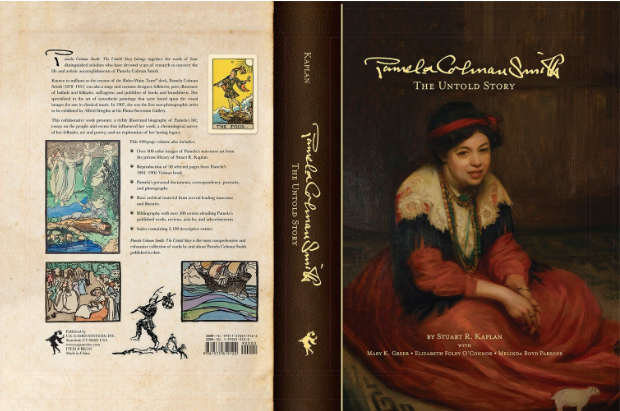
I am thrilled to announce publication of my latest book, Pamela Colman Smith: The Untold Story. The journey to publication was an extraordinary one, first, because I was able to work with an amazing group of collaborators: Stuart Kaplan, president of USGames Systems Inc., Elizabeth Foley O’Connor and Melinda Boyd Parsons; and second, because of what was involved in researching Pixie’s accomplishments, walking in her footsteps, and working with my collaborators. Stuart has long wanted to gift the world with a beautiful art book featuring his extensive collection of the works of Pamela Colman Smith. We all wanted the world to know about this extraordinary woman, set the record straight on what is known about her, and give others the opportunity enjoy her many gifts as we have.
During our research we discovered many hundreds of articles written about Smith, appearing around the world over a mostly fifteen year period, plus there are letters giving insights into some periods of her life. All works by and about her, as well as a list of all known communications and artworks, are available in the extensive bibliographies.
In the summer of 2017 I took a tour group to Pixie’s final home in Bude, Cornwall. We dowsed for her lost grave in the local cemetery. We had dinner with Nikki Saunders whose grandparents had been good friends with Pixie and our tour group stayed at the then-King Arthur’s Castle Hotel (now Camelot Castle Hotel) in Tintagel where she stayed with her father in 1899, and where she met theatre impresario Henry Irving for the first time. (The hotel has hardly changed at all!)

Rather than me telling you all about the book, I’ll direct you to four reviews and an informative interview with Elizabeth Foley O’Connor:
Interview with Elizabeth O’Connor by Lakshmi Ramgopal
Video review by Arwen Lynch (with a look through the book itself)
I also recommend this earlier blog post where I speculate about Pixie’s design for the Tarot deck based on an article she wrote in 1910 (the year after she completed the Tarot deck) concerning what’s most important in stage decoration.
Everyone interested in Pamela Colman Smith will want to get this book in which her life and works are so well presented. Serious collectors may want the signed and luxurious Limited Edition, that’s only available here.
Almost everyone has noted that the Rider-Waite-Smith Tarot images, especially for the Minor Arcana, look like scenes in a stage play. This is not unexpected since Pamela Colman Smith spent much of her early life involved in the theatre, from miniature stage productions to set and costume design to her own costumed story-telling performances. She even wrote two articles on set design and decoration.
I here present selections from her article, “Appropriate Stage Decoration,” that appeared in The New Age magazine (7:5, June 2, 1910. pp 7-9) shortly after the deck was published. I think you’ll find that it will heighten your appreciation of her Tarot cards. I’ve interspersed commentary that shows possible relevancy to her creation of the deck. Pamela begins:
ABOUT us is the glowing beauty of the world, with its leaves and flowers, rags, gold and purple. Kings on thrones of iron, beggars on beds of clay, laughing, weeping, dreaming.
Notice how Smith poetically evokes the scene before our eyes, weaving together shape and color with emotion. My own research fifteen years ago of nearly a hundred people demonstrates high agreement in the assignation of similarly-related emotions to individual cards in the RWS deck.
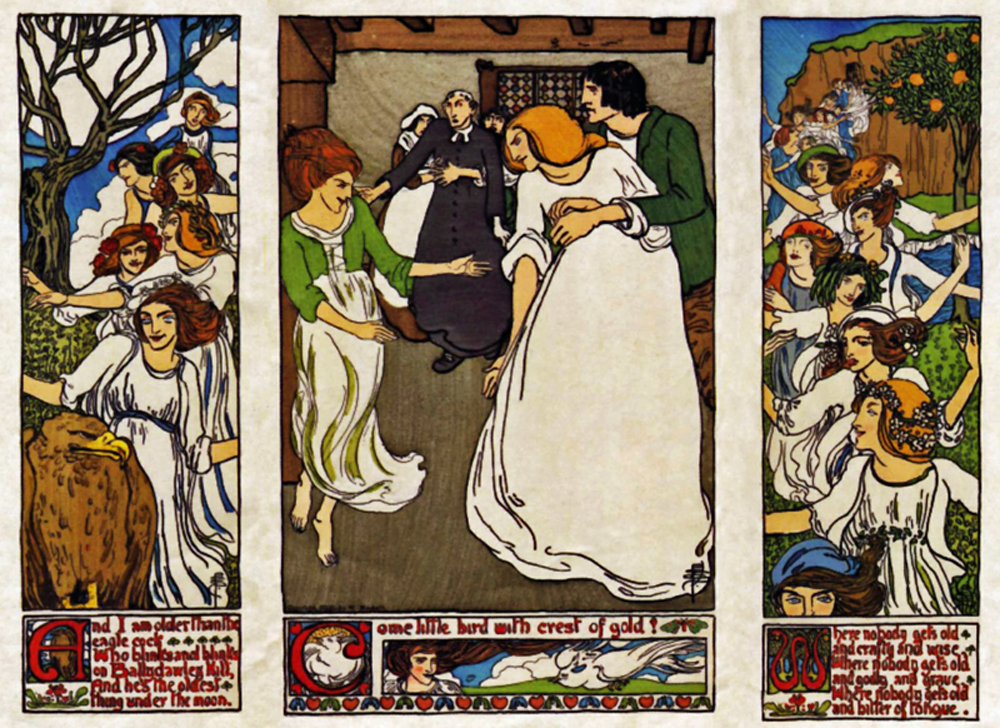
Land of Heart’s Desire
This pageant of life moves before us, intensified, in the theatre.
Theatre, Pamela tells us, is an exaggeration of life, a march of characters before our eyes. In a tarot reading we have a progression of scenes whose figures are comparable to ourselves and to other people with whom we are involved. It is this intensification of a personal issue in people’s lives that allows them to recognize a repeating theme and, if desired, begin to change it.
People go, most of them, to the play to be amused, and in spite of themselves, are often tricked into a mode of thinking quite contrary to their usual habit of thought. That is why the theatre is the place where all beauty of thought, of sound, of colour, and of high teaching, comes to be of use.
In the U.S. for instance, Tarot, for legal purposes, is billed as entertainment—an amusement that ‘tricks’ querents out of the usual ruts in their thinking, turning the experience into a place of ‘high teaching.’
All arts are branches of one tree.
We can picture this as tree of life and wisdom. It is a reminder of, “As above, so below.”
There in the theatre, unconsciously, the onlooker is moved, or interested, and finds himself agreeing or disagreeing with the playwright and every time he enters a theatre he comes out with a little more knowledge than when he went in. Agreeing or disagreeing, it brings uppermost in his mind some thought which crystallises and becomes a new intelligence.
In many circumstances the information provided by readers is not unknown to their querents, but its significance is usually heightened or it is seen as part of a larger pattern. And it is not so important that querents agree completely with what a reader says. Rather the important thing is that they leave with greater insight than when they came in. This is what we hope for: a new and beneficial realization or insight, or as Pamela expresses it, “some thought crystallized.”
Theatre-going is a habit, where one cultivates a new kind of observation, a new pair of eyes and ears.
In order to enter into this new kind of observation one must have, in Coleridge’s phrase, “a willing suspension of disbelief.” We accept for a moment that mere cards are mirrors of the soul, reflections of our personal issues with answers to our questions. Furthermore, when we make reading our own cards a personal habit we can observe our own patterns of thought and so recognize where we are prone to delude ourselves.
Pamela disparages the then-modern vulgar theatrical display of too realistic scenery—real trees, flowers and animals—that she called “a self-conscious sham without purpose or meaning.”
Those in power have not remembered that illusion is the aim of the theatre. It is a great game of pretence that recalls the time when, as children, we baked stones in the sun for cakes, and feared the dragon that lurked behind the garden wall, or by the pond. A remnant of that imaginative life we re-live in beholding a play set forth before our eyes.
It is through a playful sense of analogy among the figures on the cards and our everyday situations that we are able to face our own dragons.
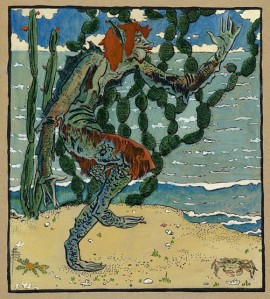
Caliban from The Tempest
If the illusion is good, we follow it more easily, and illusion to be good need not be realistic. Realism is not Art. It is the essence that is necessary to give a semblance of the real thing.
Absolute correctness in dress or scene does not necessarily give the illusion. Everything must be exaggerated in order that it may be visible across the footlights.
A deck that is too real may be off-putting. A card depicting an office-worker with a computer may be too “real” an image to correlate with someone’s job as carpenter or herbalist. An idealized movie star as Knight of Wands could do little to suggest a problematic boy friend. By contrast, a fantasy fairy tale. as in Pamela’s faux-medieval Minor Arcana, may be easier to inhabit. Moreover, it can help one see the mythic dimension of one’s own life.
The designer must insist on the balance being kept, and work in harmony with, and not be ruled by, the producer or stage manager. Of course the producer must have confidence in the designer to complete his work.
We may take this as a statement of the working relationship between Smith and Waite, in which Smith was cognizant of the importance of not being ruled by Waite, the stage manager/producer. Likewise, Waite apparently gave over illustration of the Minor Arcana cards primarily to Smith, with confidence in her ability to do justice to the task.
Regarding decks that are slavishly based on their predecessors, Pamela complains that all too often costumes are “hired merely in the tradition of the part, the model having done duty in many revivals.” So we should not be surprised when her deck takes a decidedly new form of expression. It might even make one wonder what Pamela would have thought of so many RWS influenced decks.
A great many people find her colors garish. When critiquing the artistic effect of her cards we should take into account that for Pamela:
Colours are forces but little understood. Strong colour is disliked, and perhaps the fear and hatred of strong, clean colour is due to ignorance.
She asks us to:
Observe the work of the French impressionist painters, who use red, blue and yellow side by side to get the effect of light and atmosphere. Is it the fear of the dreaded accusation of vulgarity? I believe the public would prefer the effect got by the use of strong primitive colour, if they saw it.
While some may see her strong colors as a call to vitality and a celebration of life like that perceived in the French theatre posters of the period, we see here that she was also influenced by the impressionist experiments in color theory.
How rarely does one see an entire production welded together into a thing of beauty by artist hands?
As we’ve already seen, historical correctness is secondary to an exaggerated illusion welded into “a comprehensive thing of beauty.” She further claims that costume is more important than scenery. The latter, she notes, should be kept simple and in harmony with the costumes. Nevertheless, Pamela ends her article with a plea for a dramatic library that would provide historical details for design purposes (much as can be found with simple google searches today). She asks, “Where would one look for the dress of a Jewish woman in England in the year 1185?” and answers herself, “There is the material to go on, given the knowledge of where to find it.” Here’s one source.
I read this as Pamela’s call for historical awareness at the same time that she observes the primacy of dedication to the art plus the necessity of illusion as essential to having one see with “a new pair of eyes and ears.” This is a formula with which all tarot readers have to contend. And then, knowing what we know of Pamela Colman Smith, we must add a significant dash of intuitive awareness allowing us to experience other realms of perception.
For the definitive book on her life and work, fully illustrated with never-before-seen art and photographs, please check out Pamela Colman Smith: The Untold Story (2018, USGames Systems, Inc.).
Please add your own thoughts in the comment section.
This spring I am again involved in Magical Tarot tours of the British Isles. But I want to speak here about communing with the land, which we will focus on even more on this year’s journeys to “Sacred Scotland” and “Merlin’s Britain.” These are things you can do in your own community as well as sacred sites—a city park can be as good as a meadow or forest. Even buildings have their energies and stories. Your intention may be to gain knowledge about nature, the land or the place: past, present or future. Or you may be on a quest for personal insight. I’ll mention just a few of my favorite methods that can be used separately or together.
FINDING A POWER SPOT
Go to your place of engagement.

With or without shoes, move slowly, with your intention in mind, using your breath to enter a meditative state of open awareness.
Open all your senses and try to determine a flow or confluence of energies. This energy focus may be found in trees and plants or landmarks or even sounds or air flow. Some people use kinesiology, a pendulum or dowsing rods to assist them.
One time I was walking by a forest stream with many little waterfalls and found myself going back and forth until I came to the exact spot where all the ambient sounds seemed to join together equally in perfect balance and harmony. O Ecstasy of the spirit!

A second example was following a nighttime ritual inside the Egyptian Step Pyramid at Saqqara. Standing in the outer temple complex I walked around until I found myself triangulating a position at the juncture of the energies of the pyramid and two other structures. Once I found it, I looked up and the full moon was, just at that moment, cresting the top of the pyramid, resting on its point. When this kind of magic happens I quietly express my gratitude and try to enter into oneness with the place.

Dowsing for Pamela Colman Smith’s grave in Cornwall
YOUR TAROT GUIDE
Take the Major Arcana from your favorite Tarot deck to a place that intrigues you. You’ll probably want an intention in mind. For instance, you may ask to be guided to a power spot or to receive information about the place or its history, or to get insight regarding a personal concern. Get comfortable. Select a Major Arcana card as your guide either randomly or by conscious choice. If in doubt, select the Hermit.
Gaze at your card until you can recreate it in your mind’s eye while speaking your intention. Close your eyes and breathe in the place while asking your guide to come to you. What appears in your mind’s eye may or may not look like a figure on the card. If it doesn’t, then ask if it is your Tarot guide or sent by your guide. Once a figure is affirmed, ask for guidance regarding this place or the knowledge you seek. Be sure to thank and release this guide and return fully from the parallel astral world in which you met.
NATURE AS ORACLE
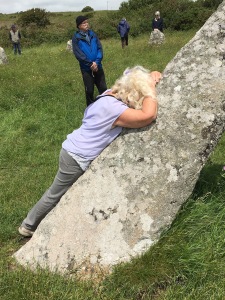
Communing with the central Boscowen-un Stone
Select a special rock, piece of plant or wood, or other object (I’ve done this with trash found on my walks!). If possible, hold or touch this “other” and speak aloud. Describe it as thoroughly and objectively as you can—no metaphors or symbols—but rather colors, shape, texture, smell, even taste—all the concrete and subtle details. Next, describe its energy affect and attitude. Is it distant or welcoming? Open and yielding or harsh and inflexible? Whimsical or practical? Or some combination of things? Ask if you can enter into it (the “it” is now a “thou”) and, if you receive an affirmation, then become this other being, stretching or compressing yourself into all it’s nooks and crannies. Let your human self ask this nature-being your question and let it speak what it has to convey. Express your gratitude and remain a few moments in that place of emptiness that follows purpose, for the greatest gifts often reside there.

Diving deep into the roots of Avebury
Check out this video by Martin Shaw. Although a promo for his new book it is really an inspiration for walking the hills with consciousness. https://youtu.be/d0T7UP1U1Ts. Thank you, Carrie Paris.
I invite you to join me, Linda Marson of GlobalSpiritualStudies and Jamie George of Glastonbury’s Gothic Image Books and Tours on our special journeys this coming May. Register now to get special rates, information and view fabulous videos in the links below.

Tarot Magic in Sacred Scotland – 14 May to 23 May, 2018
Tarot Magic in Merlin’s Britain – 23 May to 1 June, 2018
London Workshops with Mary Greer and Linda Marson – 12 & 13 May, 2018
Linda Marson’s Tarot Nav: GPS for Life, courses
Interview with tour leader extraordinaire, Jamie George
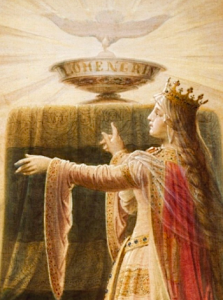
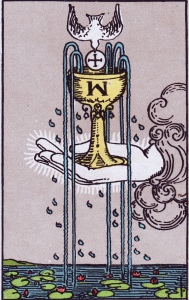
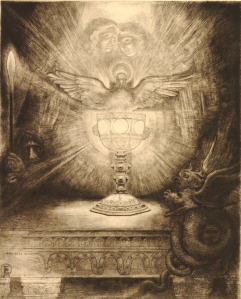
The Waite-Smith Ace of Cups image is not unique. A winged figure surmounts a fountain from which streams water in the Visconti-Sforza card. In the Marseille deck two of the aces (Wands and Swords) have a hand emerging from a cloud—a standard medieval device to indicate creation, miracles and gifts from a Divine source. We also find similarities in the pictures above. The first one is from Wilhelm Hauschild’s Temple of the Holy Grail (1878) and the third one is Santo Griaal by Rogelio Egusquiza (acquired by the British Museum in 1901). By the way, if you are Pagan, like me, I encourage you to look at the Christian references as psychological metaphors. Read Part 1 here.
Hand & Cloud
To display His divine nature, the hand of God is often depicted emerging from a cloud which hides his body, veiling us from his power as no person could see Him and live. As it is the right hand, it is actively giving the viewer one of the four sacred treasures found in the myths of many cultures. In the Talmud the Cup of Blessing is held on five fingers of the right hand representing the five leaves that protect a rose from its thorns. This image signifies a divine gift in the form of a supernatural vision (the cloud) that is often the starting point for a spiritual quest.
Dove & Host
Waite has a lot to say about the dove, describing it as the invocation and descent of the Comforter or Holy Spirit to renew the virtue of the Grail and to consecrate the elements.
“In England during the Middle Ages . . . the Eucharist was reserved in a Columbarium, or Dove-House, being a vessel shaped like a dove. It recalls some archaic pictures of a Cup over which a dove broods and the descent of a dove on the Graal.” …
“There is the flight of the mystical dove from the casement to inmost Shrine, as if the bird went to renew the virtues of the Holy Graal.” …
“The Dove descends from Heaven carrying the Arch Natural Host to renew the virtues of the Stone [the form the Grail takes in some of the stories].” …
“O central point and sacred meeting-place of all the sacraments, there falls the Bread, broken within the Wine-Cup, and from both issues one living Spirit of Life Divine.” …
“On Good Friday, by the descent of a dove from heaven, carrying a sacred Host . . . the crown of all earthly riches were renewed.”
The Holy Spirit represents the life-giving spirit of air, and it was present at the baptism by water of Jesus, the awakening into a new life:
“As soon as Jesus was baptized, he went up out of the water. At that moment heaven was opened, and he saw the Spirit of God descending like a dove and lighting on him. And a voice from heaven said, “This is my Son, whom I love; with him I am well pleased.” Mark 1:10-11.
Additionally, the Dove maintains its pagan association with Goddess Venus/Aphrodite and with Love (Waite includes the ancient pagan mysteries in the Secret Tradition). The Dove blesses with supernatural gifts, like the gift of tongues (pictured as Yods, see below), and so it can be associated with the ancient “language of the birds” or gift of divination and with miracles. Waite favors the idea of Grace: “it is grace which fills the heart; it is the Holy Spirit of God which makes holy the spirit of man.” Grace, equated with the Hebrew word Chesed, is a blessing that gives guidance and protects us from the dangers of earthly power and adversity.
So, the Dove can be seen as the descent of Spirit into flesh, of the supernatural into the natural, a theme repeated by the cross on the Host composed of the vertical axis of spirit and the horizontal of matter. (The cross, which represents Christ’s suffering and sacrifice on the cross, becomes a blessing.)
I should note that Waite was known to have a prodigious and exacting memory. He was extremely precise in his use of language, so when an odd phrase appears it is usually a sign that he is quoting a source to further elucidate his meaning. The internet has made it possible to find a good number of these allusions.
For instance, for Waite the Host is the “panis quotidianus that has been changed into the panis vivus et vitalis“: that is the everyday bread is transformed into a living and vital bread. This quote from Waite refers to a popular hymn by Thomas Aquinas (circa 1264) called the Lauda Sion Salvatorem. It speaks of the Eucharist and presents the transformation of bread and wine ending with a familiar maxim “as above, so below”:
Here beneath these signs are hidden
Priceless things, to sense forbidden,
Signs, not things, are all we see. . . .Living bread, thy life supply:
Strengthen us, or else we die,
Fill us with celestial grace. . . .Thou, who feedest us below:
Source of all we have or know:
Grant that with Thy Saints above,
Sitting at the feast of love,
We may see Thee face to face.
Spiritual nourishment, the Host, is sent by the Holy Ghost; in many of the Grail stories it is found to heal all wounds.

Cup, Grail and Fountain of Living Waters
This is the signature image of this card and is filled with meaning on so many levels. We will touch on only a few. As container, it is a major symbol of the receptive feminine and, in Christianity, the womb of the Virgin Mary, the seat of creation and manifestation of Love, esoterically seen as “the Bride”. It is a vessel in which things are “cooked,” making raw materials capable of providing rich nourishment and even, in alchemy, changing lead into gold. It is the cup of transformation containing the waters of life in which water is changed into wine and then into blood. It is the cauldron of Dagda in Celtic myth from which no company ever left unsatisfied.
“The message of the Secret Tradition in the Christian Graal mystery is this: The Cup corresponds to spiritual life. It receives the graces from above and communicates them to that which is below. The equivalent happens in the supernatural Eucharist, the world of unmanifest adeptship, attained by sanctity [Grace].”
Both cup and water represent the soul.
The Practicus Ritual in Waite’s Fellowship of the Rosy Cross initiates one through an encounter with the Living Waters. First we are informed that Water symbolizes the emotions, desires, and psychic nature of earthly man. But this is not the Water one is to encounter in the ritual, “The Waters that are below desire after the Waters that are above. . . . May the peace of their Union be upon us; be we dissolved therein.”
“The Spirit of God moved upon the face of the Waters, and the Spirit of the Most High God shall move upon the Waters of the Soul. . . . The stilled waters of the soul receive the Spirit of God moving upon the face of its waters. . . . Open thy heart, O Brother of the Rosy Cross, and receive the Water of Life.”
“Fountain of fountains, and of all fountains. Chalice of saving rain. Grace on the soul descending, as rain on the dry grass. Life-giving Rain of Doctrine. Mystical Fruit of the Doctrine. Dew of Divine Speech, falling in stillness on the heart, filling the soul with Knowledge. Enter into the heart and purify; come into the soul and consecrate.”
The image is one of both the Baptismal font and the Eucharist. “A Eucharistic allegory concerns [the dissolution] of the body by Divine Substance communicated to the soul, putting an end to the enchantments and sorceries of the five senses” and to the suffering on the cross (mentioned earlier).
This leads us directly to the five streams coming out of the cup.
 Five Streams
Five Streams
Why five streams of water and not the four that Waite specifies in Pictorial Key to the Tarot? Furthermore, Bible readers all know that there are four streams that come out of Eden. This could be an error either on the part of Waite or Pamela Colman Smith. Or, it could veil a secret: These five streams might, after all, represent the five senses (see the quote immediately above), or the five ways of salvation and five gates of grace (from Masonic ritual), or the five wounds of Christ, the five points of the Pentagram, the five petals of the rose that rest on five leaves (the fingers), or the four elements plus aether—the quintessence. In terms of the symbolism, five yields far more relevance according to Waite himself:
“In the Longer Prose Perceval we have seen that there is an account of five changes in the Graal which took place at the altar, being five transfigurations, the last of which assumed the seeming of a chalice, but at the same time, instead of a chalice, was some undeclared mystery: so the general as well as the particular elements of the legend in its highest form offer a mystery the nature of which is recognised by the mystic through certain signs which it carries on its person; yet it is declared in part only and what remains, which is the greater part, is not more than suggested. It is that, I believe, which was seen by the maimed King when he looked into the Sacred Cup and beheld the secret of all things, the beginning even and the end. In this sense the five changes of the Graal are analogous to the five natures of man, as these in their turn correspond to the four aspects of the Cosmos and that which rules all things within and from without the Cosmos.”
I believe that despite their blue color, the five streams best represent blood, for as Marie-Louise von Franz tells us, “Grace was depicted as a fountain of Blood from the five holy wounds of Christ,” The Psychological Meaning of Redemption Motifs in Fairytales.
 But it is in Evelyn Underhill, Anglo-Catholic author of a well-known book on mysticism, who perhaps reveals the deepest mystery. Underhill was a student or acolyte of Waite, having joined his branch of the Golden Dawn in 1904 and achieving at least four initiations. She wrote for Waite’s Horlick’s Magazine and published a novel in 1909 featuring the effects of the Holy Grail on a woman who came into its possession. In an article titled “The Fountain of Life” in the Burlington Magazine (1910) Underhill examined the fountains of water and of blood depicted on several religious works of art including the famous Ghent Altarpiece (right). She notes that baptism and penance which ‘renews the grace of baptism,’ are still spoken of by Catholic theologians as ‘effusions of the Precious Blood,’ i.e., of grace. She went on to describe:
But it is in Evelyn Underhill, Anglo-Catholic author of a well-known book on mysticism, who perhaps reveals the deepest mystery. Underhill was a student or acolyte of Waite, having joined his branch of the Golden Dawn in 1904 and achieving at least four initiations. She wrote for Waite’s Horlick’s Magazine and published a novel in 1909 featuring the effects of the Holy Grail on a woman who came into its possession. In an article titled “The Fountain of Life” in the Burlington Magazine (1910) Underhill examined the fountains of water and of blood depicted on several religious works of art including the famous Ghent Altarpiece (right). She notes that baptism and penance which ‘renews the grace of baptism,’ are still spoken of by Catholic theologians as ‘effusions of the Precious Blood,’ i.e., of grace. She went on to describe:
“, , , a fountain which is filled by the Blood flowing from the Five Wounds. The Soul, or ‘Bride,’ holds out her heart, and the blood from the wounded side of Christ falls upon it, causing flowers to spring up from the place which has been touched by the vivifying stream. The Precious Blood then . . . stands not merely for an emblem of the Passion, Redemption, or the Eucharist, though it includes all these manifestations of Grace, but for the medium of communication of the Divine Life . . . since for ancient and mediaeval thought the spirit of life resided in the blood.”
Given that the Aces are also seen by Waite as the four Celtic treasures, I’d be remiss in not presenting this option from Celtic Myth and Religion by Sharon Paice MacLeod:
“In Cormac’s Adventures in the Land of Promise, Cormac has a vision of the sacred center of the Otherworld where he saw a shining fountain with five streams flowing out of it. He is told that it is the Fountain of Knowledge [others call it the Well of Wisdom], and the five streams are the five senses through which knowledge is obtained.”
Drops of Dew or Yods
These drops, in the shape of the Hebrew letter Yod are found on many of the Tarot cards, generally signifying divine Grace. Shaped like a flame a Yod is the divine spark of creation that is the foundation of all the other letters and is the first letter in the Tetragrammaton or four-letter name of God. There are 26 yods and Eoin Keith Boyle notes in the comments that this is the sum of the 4-lettered name of God, the Tetragrammaton, in Kabbalistic gematria. They are also the shape of the tongues of fire at Pentecost:
“They saw tongues like flames of a fire that separated and came to rest on each of them. And they were all filled with the Holy Spirit and began to speak in other tongues as the Spirit enabled them.” Acts 2:3-4.

The alchemist Thomas Vaughn, in a compendium by Waite, calls it the divine spark or star-fire that is sympathetically attracted to its origin in God. It is spirit fructifying the soul.
These drops can also be seen as alchemical dew. Thomas Vaughn again explains that divine dew penetrates and transforms all that is physical. Waite claims that for the Rosicrucians “dew is light, coagulated and rendered corporeal. . . . When digested in its own vessel it is the true menstruum of the Red Dragon, i.e., of gold, the true matter of the Philosophers.”
Pool of Water
[In the beginning] “the Spirit of God moved over the face of the waters.” Genesis 1:2.
It is the soul that desires union with the spirit, “The Waters that are below desire after the Waters that are above.”
This is also the generative water of renewal and rebirth. It also represents the emotions which here have become serene and calm, being fed by the waters of the Holy Spirit. In the parlance of Carl Jung it is the rich and fertile pool of the unconscious psyche—the soul. And Evelyn Underhill already explained that the blood from Christ’s wounds causes flowers to spring up—in this case water-lilies that grow only in sweet waters, reaching up from the mud toward the light. Regarding sweet waters, in Waite’s book of aphorisms, Steps to the Crown, we find: “The Cup of bitterness ceases to exist for him who has drunk from the chalice of immortality”.
W or M ?
Finally we come to the major controversy associated with this card—What is the significance of the letter on the cup? The fact is that we will never know, but we do have some very likely possibilities, and knowing Waite, all of them may have been what was intended, for Waite saw all symbols as multi-valenced.
 MacGregor Mathers, in his 1888 book Tarot: A Short Treatise on Reading the Cards claims that an inverted M on the front of the Spanish Ace of Cups represented the waters of creation in Genesis and all that remains of an Egyptian motif of twin serpents (as per this 19th century deck reproduced in the Cagliostro Tarot by Modiano of Italy). The Golden Dawn paper on the Tarot, “Book T,” says, “The great Letter of the Supernal Mother is traced in the spray of the Fountain.”
MacGregor Mathers, in his 1888 book Tarot: A Short Treatise on Reading the Cards claims that an inverted M on the front of the Spanish Ace of Cups represented the waters of creation in Genesis and all that remains of an Egyptian motif of twin serpents (as per this 19th century deck reproduced in the Cagliostro Tarot by Modiano of Italy). The Golden Dawn paper on the Tarot, “Book T,” says, “The great Letter of the Supernal Mother is traced in the spray of the Fountain.”
First it is note-worthy that the letter is shaped exactly like Pamela Colman Smith’s Ms and not like her Ws
and not like her Ws .
.
The main contenders for W are:
Waite (see the monogram on the Ten of Pentacles)
Water (“the implicit is that the Sign of the Cups naturally refers to water” PKT.)
Womb
Wisdom (more specifically, the Celtic Well of Wisdom)
Woman
The main contenders for M are:
Mystery (“For this is the chalice of my blood, of the new and eternal testament: the Mystery of Faith”).
Mem (or Maim, Hebrew for “water”)
Mary (or Mara, which also means “bitter sea”)
Mother (Matter. As Supernal Mother she is associated with Binah on the Tree of Life and the 2nd letter of the Tetragrammaton, He.)
Mercury (an alchemical maxim: “What wise men seek in Mercury is found”)
I believe that the letter is M and that it stands for Mystery, as viewed from above by the Holy Spirit. It is probably the word Waite uses most in his books where it is usually capitalized. To support this I have found almost this identical summary statement in several of Waite’s books:
“[In conclusion] the maxim which might and would be inscribed over the one Temple of the truly Catholic Religion when the faiths of this western world have been united in the higher consciousness–that is assuredly ‘Mysterium Fidei’–the mystery which endures for ever and for ever passes into experience.” HCHG, p. 469
We might also view the letters like this:
Waite – Mystery
Water – Mem
Womb – Mary/Mother
Wisdom – Mercury
An Act of Imagination
I suggest one final way of getting at the deeper meaning of this card.
Imagine for a moment that you are the Chalice and, perhaps, the liquid in the chalice. Picture yourself reaching up for the host held in the beak of the dove. You might see yourself as a baby bird stretching up to be fed by a parent. Can you experience the yearning? Or you may be a font of water that wells up from a deep source. Feel the draw from above and your yearning toward the source of that draw. Become aware of the wounds gathered through your earthly experience. The water (or blood) within you could begin to spill over, rising up and falling out in a continuous stream. Can you let yourself go, surrender to the movement, and then to gravity so that you fall into the pool beneath? What happens when you spill into that pond? Where do you go? How do you reflect back what is above?
One final characteristic of Cups, which Waite mentions over and over again through his discussion of the suit, is fantasy—the ability to imagine super-sensible things and have experiences of what he calls the Arch-Natural world. While there are dangers in doing so (the Seven of Cups), it is in through mystical experience, first accessed through the door of the imagination, that we are ultimately able to commune with Spirit. I hope to speak more about this in a third post on a Jungian interpretation of this image.
See also:
Part 1: Waite’s Eucharistic Ace of Cups.
Part 3: A Jungian Approach to the Ace of Cups

Announcing two Tarot Tours this coming summer in the British Isles. Last year’s trip, Tarot Magic in Merlin’s Britain, sold out early. We are doing it again, with a Tarot trip to Sacred Scotland preceeding it, and a discount if you go on both. Don’t let these journeys pass you by! Sign up before the November 30th deadline. Above is a photo of our private full moon sunrise ceremony in the circle at Stonehenge.
Just two weeks ago I discovered that the hotel where we stayed while searching for Tarot artist Pamela Colman Smith’s burial place, was a hotel she actually stayed at as a young woman. It was in 1897, the year King Arthur’s Castle Hotel opened, with its magnificent roundtable at which we did readings, that Pamela met Henry Irving of the Lyceum Theatre fame. Subsequently she toured with the Lyceum Theatre and designed costumes and sets, getting her nickname, Pixie, from her foster mother, the actress Ellen Terry. Here is what is now called the Camelot Castle Hotel in Tintagel, with Merlin’s Cave in the far bottom right.
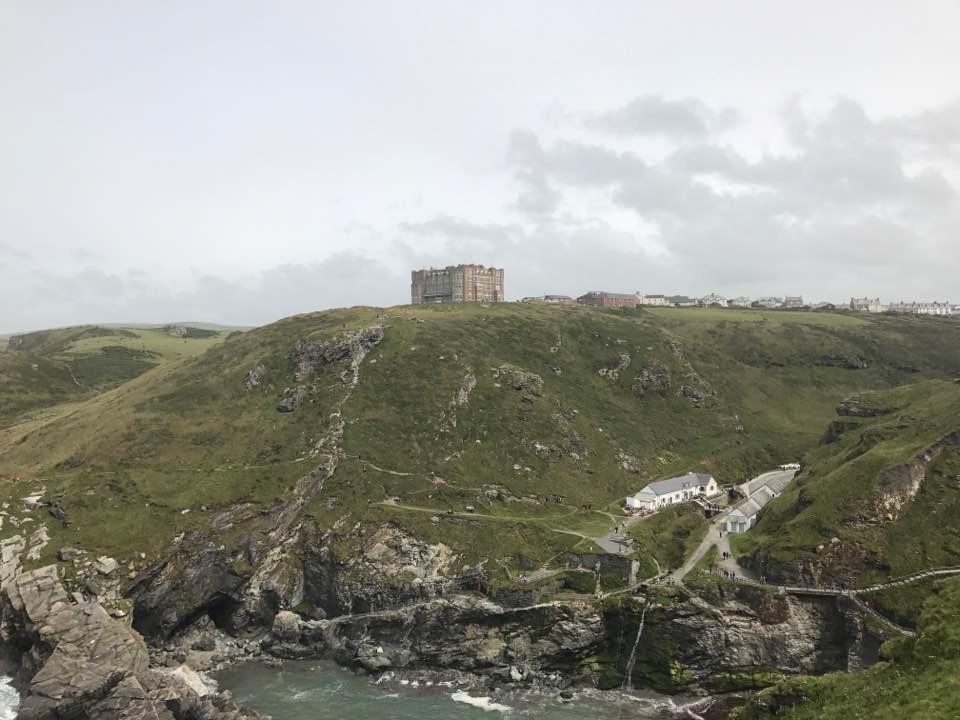
I can’t begin to tell you all the amazing things we encountered on our journey: sacred wells in out of the way locations; stone circles, several of which we had to ourselves; the special fairy glen; a ritual on a hilltop labyrinth; Glastonbury Tor and Chalice Well where Dion Fortune made her home.  One of the most magical moments was our using dowsing rods to find what we believed was Pixie Smith’s unmarked grave. Linda dropped her pendulum, hearing it fall. We searched for it in vain, only to have the bus driver when we returned ask who had dropped a pendulum on the bus. It was Linda’s. That night at the Camelot Castle Hotel we used the pendulum to ask Pixie questions about her life – and it was months later that I discovered from one of her letters that she had probably drunk her favorite “Opal Hush” drink in that same bar 120 years before.
One of the most magical moments was our using dowsing rods to find what we believed was Pixie Smith’s unmarked grave. Linda dropped her pendulum, hearing it fall. We searched for it in vain, only to have the bus driver when we returned ask who had dropped a pendulum on the bus. It was Linda’s. That night at the Camelot Castle Hotel we used the pendulum to ask Pixie questions about her life – and it was months later that I discovered from one of her letters that she had probably drunk her favorite “Opal Hush” drink in that same bar 120 years before.
The Tarot Magic in Sacred Scotland Tour is
14-23 May 2018
and will feature Tarot readings in sacred sites for gaining insight into your own spiritual journey…readings whose messages will continue to unfold for years to come. Experience:
- Inverness and surrounding area – Prehistoric Clava Cairns and standing stones, Rosemarkie Fairy Glen, Loch Ness
- Orkney – Skara Brae, Maes Howe, Stones of Stennes, Ring of Brodgar, archaeological dig on the Ness of Brodgar
- Iona – Abbey, Nunnery, St Columba’s Chapel
- Standing stones at Kilmartin.
More information: https://globalspiritualstudies.com/travel/sacred-scotland/
The Tarot Magic in Merlin’s Britain Tour immediately follows on
23 May – 1 June 2018
and takes us to:
- Stonehenge
- Avebury and West Kennet long barrow
- Glastonbury and surrounding area – Chalice Well, the Tor, Glastonbury Abbey, Cadbury/Camelot
- Tintagel and surrounding area – Tintagel Castle, Merlin’s Cave, St Nectan’s Glen
- Boscastle – Museum of Witchcraft and Magic
- South Cornwall – Boscowen-un stone circle, Merry Maidens stone circle, holy wells of Madron and Sancreed.
More information: https://globalspiritualstudies.com/travel/avalon-to-camelot/
Watch this video of our trip, created by Linda Marson, to catch just a little of the magic:

Pamela Colman Smith was known for telling Jamaican folk tales about the spider-man trickster figure, Annancy, and also for her toy theatre performances. The toy theatre scene shown below is from her play, Henry Morgan, based on a real life Welsh pirate who became lieutenant governor of Jamaica. The photo above of PCS telling a folk tale using her cutout figures was recently discovered by Dawn Robinson in Cornwall glued into a copy of The Russian Ballet.

Toy theatres were nothing new, as from 1811 they had become a popular pasttime in pre-television, Victorian England (check out this toy theatre site). Below are two newsreels of the original Pollack’s Toy Theatre construction showing how Pamela herself would have made her theatres and especially how she would have used stencils to color her illustrations for “The Broad Sheet”, “The Green Sheaf” and other works.
Finally, join author Ronald Hutton (Triumph of the Moon, Pagan Britain and The Witches) on a tour of modern day Pollack’s Toy Museum and view the Toy Theatres seen in the old newsreels above (view about half way through Hutton’s video).
A photograph of a modern toy theatre using figures from Pixie’s Tarot deck can be found on Pinterest, but since I don’t have the original source for the photo I won’t show it until permission is given by the creator.





 Mary K. Greer has made tarot her life work. Check here for reports of goings-on in the world of tarot and cartomancy, articles on the history and practice of tarot, and materials on other cartomancy decks. Sorry, I no longer write reviews. Contact me
Mary K. Greer has made tarot her life work. Check here for reports of goings-on in the world of tarot and cartomancy, articles on the history and practice of tarot, and materials on other cartomancy decks. Sorry, I no longer write reviews. Contact me
Recent Comments